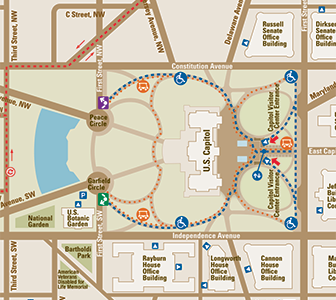
The Capitol Visitor Center offers periodic professional enrichment programs for teachers. Programs are typically offered on Saturdays in November and February, and during the week at the end of June or beginning of July.
To make reservations or to suggest a topic for a future workshop, please email education@visitthecapitol.gov.
Previous Professional Enrichment Programs:
The Reflection of a Nation: Building and Expanding the U.S. Capitol, 1793 – 1892
Speaker: Tom Fontana, Director of Communications and Marketing Division, U.S. Capitol Visitor Center |
We Shall Overcome: Congress Passes the Voting Rights Act of 1965Speaker: Dr. Kate Scott, Associate Historian, U.S. Senate Historical Office This workshop featured a lecture about the role that activists, members of Congress and President Johnson played in the final passage of this historic bill. Teachers used photos of the event to explore artifact contemplation as a classroom technique. In addition, participants visited the President’s Room where the Voting Rights Act of 1965 was signed. |
American symbols found in art in the U.S. CapitolSpeaker: Dr. Michele Cohen, Assistant Curator, Architect of the Capitol This workshop used an interdisciplinary approach to examine public art found in the U.S. Capitol. The workshop included a lecture, a tour of the Capitol, and an opportunity to share curriculum ideas with colleagues. |
Congressional Investigations: Origins, Practice and HighlightsSpeakers: Dr. Betty Koed, Historian for the U.S. Senate and Director of the U.S. Senate Historical Office Dr. Matt Wasniewski, Historian, U.S. House of Representatives, Office of the Historian This workshop focused on the congressional power to investigate, an important element of our constitutional system of checks and balances. Teachers had an opportunity to work with primary sources and visit the floor of the House of Representatives and Senate. |
Civil Rights Legislation: The Failed Civil Rights Act of 1875 and the Civil Rights Act of 1964Speakers: Laura O’Hara, Office of the Historian’s Senior Historical Web Editor, U.S. House of Representatives and Dr. Katherine Scott, Associate Historian, U.S. Senate Historical Office This workshop focused on the continuum of Civil Rights legislation, most notably the failed Civil Rights Act of 1875 as a prelude to the Civil Rights Act of 1964. Teachers worked with primary sources such as speeches made by members of Congress. In addition, they visited locations within the U.S. Capitol associated with civil rights legislation. |
Majority Rule, Minority Rights: The Similarities and Differences between the House and the SenateSpeaker: Dr. Matt Field, Exhibits and Education Program Specialist, U.S. Capitol Visitor Center This workshop focused on the similarities and differences between the House of Representatives and the Senate: the different ways they function, what the Constitution says about each chamber, and how the institutions have changed over time. Teachers worked with primary sources including the Federalist Papers, the Rules of the House of Representatives, the Standing Rules of the Senate, and the Congressional Record. Following the workshop, teachers participated in an optional tour of the U.S. Capitol. |
The Design and Construction of the U.S. CapitolSpeaker: Thomas Fontana, Director, Communications and Marketing, U.S. Capitol Visitor Center This workshop focused on the design and construction of the U.S. Capitol from 1793 to 1866. Teachers worked with primary sources including drawings of the Capitol, correspondence regarding the Capitol, and excerpts from the Annals of Congress and the Congressional Globe. Following the workshop, teachers participated in an optional tour of the U.S. Capitol. |
Philip Reid, the Statue of Freedom, and the District of Columbia Compensated Emancipation ActSpeakers: Dr. Barbara Wolanin, Curator, Architect of the Capitol, and Dr. Matthew Wasniewski, Historian, U.S. House of Representatives, Office of the Historian This workshop focused on the contributions of enslaved workers and freedmen in the building of the U.S. Capitol, and the District of Columbia Compensated Emancipation Act. Participants toured Emancipation Hall of the Capitol Visitor Center to see the plaster model of the Statue of Freedom as well as view historic documents related to emancipation in Exhibition Hall. |


